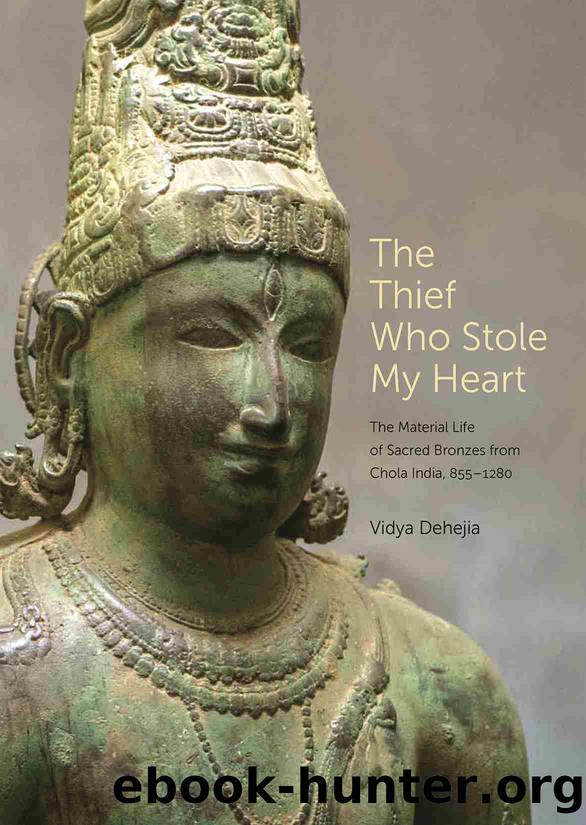The Thief Who Stole My Heart by Vidya Dehejia

Author:Vidya Dehejia
Language: eng
Format: epub
Publisher: Princeton University Press
Published: 2023-02-09T00:00:00+00:00
Figure 6.8. (a) Dancing Shiva, Gangaikondacholapuram, Ariyalur district, Tamil Nadu, ca. 1030. (b) Detail of pedestal of Dancing Shiva (fig. 6.8a), depicting woman saint Karaikkal Ammaiyar seated at far left.
Figure 6.9. Detail of Saint âMother of Karaikkalâ along pedestal of Dancing Shiva, Polonnaruwa Museum (see fig. 6.4).
Figure 6.10. Saint âMother of Karaikkal,â Tiruvalankadu temple, ca. 1030.
In the signature verse of her second poem in this mode, she describes herself as âKaraikkal pey who has sharp teeth and a fiery mouth.â55 Both the stone image on the mainland and the Polonnaruwa bronze capture the essence of the saintâs own bizarre verbal portrayal of the forest ghouls who watch Shivaâs dance, and of her own ghoulish self.
At Polonnaruwa, Karaikkal Ammaiyar is also portrayed as a less forbidding tiny figure to the far left of the pedestal of the large Dancing Shiva, where she squats sideways, gazing up at her dancing lord and sounding her cymbals (fig. 6.9). Four of Shivaâs dwarfish gana attendants, who sit facing forward, provide further accompaniment for their masterâs dance; one blows a conch shell, a second plays the flute, a third sounds the ghatam (earthen pot played as a drum), and the fourth sounds the cymbals. This more sympathetic portrayal of the saint is closer to the tone and feel of the bronze in the temple at Tiruvalankadu on the mainland, located beside the forest where Karaikkal Ammaiyarâs poetry locates her dancing lord (fig. 6.10). Sitting cross-legged with sharply delineated collarbones, depleted breasts that hug her rib cage, and raised knobbly shoulder joints, her face reflects a peaceful calm as she sounds her cymbals. In this portrayal, her shrunken body accords more closely with the tale of a beautiful young woman deprived of her fleshy contours, rather than a fearsome ghoulish creature.
In their difficulty in portraying the typical tri-bhanga or âtriple-bentâ contrapposto, Sri Lankan bronzes of Uma present us with yet another example of the sculptorsâ misinterpretation of a major aspect of Kaveri basin imagery. A mere glance at the Tiruvenkadu Uma whom we examined in the previous chapter clarifies that tribhanga requires Umaâs crowned head and lower limbs to be posed at the same angle, while the torso moves in the opposite direction (see fig. 5.2). The artist of a powerful Polonnaruwa Uma, standing over 3 feet tall together with pedestal, appears to have found this a baffling concept. His Umaâs head and torso are at more or less the same angle; for the viewer standing in front of the image, they both slope to the left, while the lower body is more or less vertical (fig. 6.11a, b). The result is an uncoordinated and somewhat ungainly effect that is especially evident through comparison with Kaveri delta images. It is intriguing though to compare this Polonnaruwa Uma with a second Uma from Polonnaruwa whose sculptor better understood the triple-bent posture and created an image that is more appropriately balanced (fig. 6.12). Images of Uma are to be found in both categories, raising the identical issues revolving
Download
This site does not store any files on its server. We only index and link to content provided by other sites. Please contact the content providers to delete copyright contents if any and email us, we'll remove relevant links or contents immediately.
| Appreciation | Technique |
Picasso by Gertrude Stein(1217)
Modeling the Head in Clay by Bruno Lucchesi(1204)
Auguste Rodin by Rainer Maria Rilke(1052)
Modelling and Sculpture by Albert Toft(999)
Louise Nevelson by Laurie Wilson(888)
The Parthenon Marbles by Christopher Hitchens(883)
Antony Gormley on Sculpture by Antony Gormley(869)
Asmat Art by Dirk Smidt(856)
You Must Change Your Life by Rachel Corbett(845)
Greek Art by John Boardman(831)
Modular Origami Polyhedra by Lewis Simon & Bennett Arnstein & Rona Gurkewitz(830)
The TAB Guide to DIY Welding : Hands-on Projects for Hobbyists, Handymen, and Artists by Jackson Morley(828)
Origami Holiday Decorations by Florence Temko(778)
Origami for Beginners by Florence Temko(771)
Spiral Jetta: A Road Trip through the Land Art of the American West (Culture Trails) by Erin Hogan(759)
The Animal Gazer by Edgardo Franzosini(741)
Metal Clay Jewelry: Projects. Techniques. Inspirations. by Louise Duhamel(731)
The Pagan's Cup by Fergus Hume(716)
The Autobiography of Benvenuto Cellini (Penguin Classics) by Benvenuto Cellini(712)
